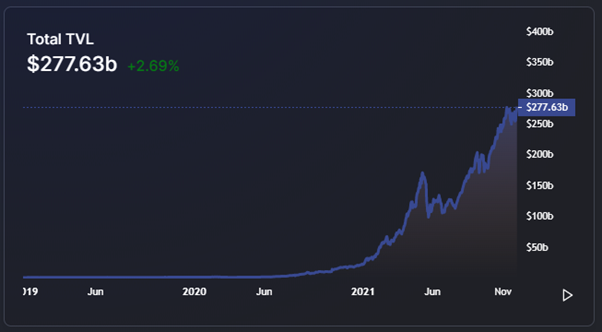Innovation is a key disruptor in every industry, and banking is no exception. Decentralized Finance (DeFi) is an essential emerging financial technology that combines blockchain technology, digital assets, and financial services. DeFi protocols aim to eliminate the role of a trusted intermediary in finance by utilizing both traditional and novel service arrangements.
Since its start in 2019, the DeFi market has grown at a breakneck speed. According to Defillama, the value of digital assets locked into DeFi services increased from less than $1 billion in 2019 to $236 billion in November 2021, with total value locked (TVL) across leading protocols reaching a new monthly high.
Now big question: What does the future look like? Is this the end of traditional banking? The answer could well lie in how banks can coexist with DeFi.
 TVL = Total Value Locked in DeFi as of November 30, 2021 (Metrics source: defillama.com)
TVL = Total Value Locked in DeFi as of November 30, 2021 (Metrics source: defillama.com)
What is DeFi?
It's important that we first take a step back to understand Bitcoin and our financial system. This will help us better appreciate DeFi’s unique advantages.
Since Bitcoin is a decentralized currency, transactions can be made without going through a bank or financial organization. However, money transfer is only the first of many more components that constitute a financial system. Lending, insurance, savings plans, and stock exchanges are among the most popular money-related services that form our system. Our financial system and its services are now entirely centralized allowing for banks, stock exchanges, insurance firms, and other financial organizations to have a regulatory body for controlling and providing these services.
A centralized financial system (CeFi) faces mismanagement, fraud, and corruption risks. But what were to happen if we were to decentralize the financial system as a whole, like Bitcoin’s decentralized money? That is precisely what DeFi does!
How is DeFi different from traditional finance?
While the main difference between traditional finance and DeFi lies in being centralized vs. decentralized. Some other differences are:
| Parameter | DeFi | CeFi |
| Governance | Administered by protocol authors or selected by token holders with voting rights. | Specified either by service providers, market regulators, and/or self-regulated organizations. |
| Collateral requirements | Due to the volatility of digital assets and the lack of credit rating, over-collateralization is usually required. | There may be no collateral or collateral that is less than or equal to the cash grant. |
| Clearing and settlement | Publishing transactions complete the settlement process to the blockchain. | Usually after a pre-defined period (varies from real-time to a few days). |
| Custody of assets | Users can store their funds in non-custodial wallets or through smart contract-based escrows. | Assets are held on behalf of asset owners by a licensed service provider or custodian (and tracked as liabilities). |
| Investor protection | By default, users incur all risks, but nowadays, private remedial mechanisms like DeFi insurance provide security from losses. | Usually done by government-mandated exposure, consumer protections, anti-fraud legislation, and insurance schemes. |
| Cross-service interactions | Services on the same blockchain, and even across chains, can integrate with other services. | Usually limited, though Open Finance and use of intermediaries are ways to have such interactions. |
This figure depicts how traditional vs. DeFi finance works in the lending space scenario:
.png?width=750&name=Defi%20and%20banks%20illustration%20(1).png) Source : Defi Beyond the hype
Source : Defi Beyond the hype
How can banks coexist with Defi?
The financial landscape is disrupting, and it is pertinent for financial institutions to accept DeFi as a long-term business model. Just like they did when blockchain was changing the way transactions were processed.
Banks were initially skeptical about blockchain, and the adoption rate was slow. But with countries like Canada, China, and the UK exploring a Central Bank Digital Currency (CBDC), this is bound to take off.
Banks are already learning from blockchain adoption and incorporating it in offering new services and updating their existing offerings. Since 2021, most major banks have been investing in crypto and blockchain-related companies.
The same applies to DeFi space. Banks need to understand that DeFi is a natural ecosystem coming out from blockchain technologies and is here to say.
We already see proof of concepts and some collaboration in this space. Recently, Netherlands-based ING Bank has analyzed the risks and opportunities associated with the exploding decentralized finance (DeFi) space.
Their paper, released a few months back, titled “Lessons Learned from Decentralized Finance” carefully weighs DeFi's pros and cons and concludes that “the best of both worlds is achieved if centralized and decentralized financial services cooperate.”
Let's explore some key steps banks can take in the DeFi space:
Contribute proactively to the development of regulations
DeFi presents a considerable chance for legacy banks to avoid the mistakes made in the open banking space, where the industry's lethargy meant that regulators had to push API-driven innovation. Banks must proactively adopt DeFi by generating novel DeFi propositions in partnership with the DeFi ecosystem. They must engage with policymakers to explore how to regulate those propositions while maintaining DeFi's decentralized characteristics.
Simultaneously, banks should modify their internal compliance routines to connect their banking services and the larger fiat economy to all the opportunities that DeFi can provide.
It's crucial to look at DeFi from the perspective of innovation. One possible path forward is for banks' compliance teams to transform their mindset from being risk-averse to adopting an innovation-first mindset.
Start offering Defi services for unserved markets
Banks must allow consumers greater access to the blockchain ecosystem through their banking services. We already see many banks offering such services globally.
According to recent findings, funding for SMEs are short of funds by as much as $5 trillion. While banks and financial platforms have been trying to find a solution, the traditional frameworks for business servicing are not a good fit. DeFi and digitization services can help bridge this gap.
Understand and involve the new generation of retail investors
Banks must move beyond the legacy mindset that they alone know how to invest money. If financial institutions want to adopt DeFi, they must accept that crypto is here to stay, and is worth trillions of dollars in value.
Today’s consumers comprise a new generation of technically sophisticated risk-takers. They are happy to diversify their investments and multiply their money in unconventional ways. This group recognizes the significance of non-digital assets and is willing to tap into the trillion-dollar crypto economy. Banking giants like Morgan Stanley, Goldman Sachs, CBA Australia, and a few other banks are already in the race to offer such services.
Conclusion
“Innovation is the ability to see change as an opportunity, not a threat" - Steve Jobs
It's natural to consider traditional 'centralized' banking infrastructure and DeFi as competing or opposing forces. But actually, their best bet lies in synergizing and working together in the future. DeFi may help currency institutions become more robust by removing the impediments and silos associated with centralized financing.
DeFi's blockchain-based ideas are likely to become ingrained in global finance's basic architecture. The ability to make money work faster, with easier loan access, and an openness to innovation are only some of DeFi’s many possible benefits.
As traditional bankers and regulators will become more familiar with blockchain technology, DeFi is poised to improve the economy's financial procedures. There could still be various hiccups along the way. But the next wave of innovation may hinge on how successfully traditional banking responds to this significant opportunity.
Nagarro, with its team of experienced domain and technology consultants, can help you ideate and get the best out of blockchain and the financial world. Want to know more? Explore our offerings and connect with us today!





